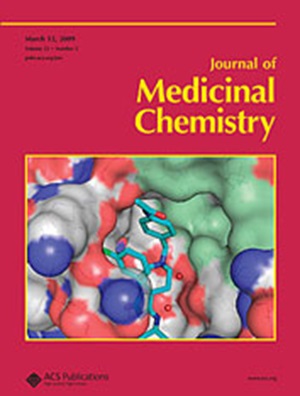利用集成化学基因组学和化学蛋白质组学进行多重靶标分析
IF 6.8
1区 医学
Q1 CHEMISTRY, MEDICINAL
引用次数: 0
摘要
在药物发现过程中,靶点识别对于阐明生物活性分子的机制至关重要。然而,传统的方法是对化合物进行单独评估,这使得高效地并行检测多种化合物,尤其是结构多样的化合物具有挑战性。本研究报告了一种名为 "化学基因组学-促进化学蛋白质组学(CGCP)"的新策略,用于复用生物活性小分子的靶点鉴定。CGCP 将化合物对全局转录或化学基因组图谱的扰动与其对靶蛋白的反应性相关联,从而实现了靶标的同步鉴定。我们根据化学基因组图谱研究了西司他醇(Cel)和其他四种与西司他醇有不同程度相似性的亲电化合物的靶标,从而证明了 CGCP 的实用性。我们在一次实验中就发现了化合物共有的多个新靶点和结合位点。CGCP 实现了多重性,提高了结构不同化合物的靶点鉴定效率,显示了其加速药物发现的潜力。本文章由计算机程序翻译,如有差异,请以英文原文为准。

Multiplexed Target Profiling with Integrated Chemical Genomics and Chemical Proteomics
Target identification is crucial for elucidating the mechanisms of bioactive molecules in drug discovery. However, traditional methods assess compounds individually, making it challenging to efficiently examine multiple compounds in parallel, especially for structurally diverse compounds. This study reports a novel strategy called chemical genomics-facilitated chemical proteomics (CGCP) for multiplexing the target identification of bioactive small molecules. CGCP correlates compounds’ perturbation of global transcription, or chemical genomic profiles, with their reactivity toward target proteins, enabling simultaneous identification of targets. We demonstrated the utility of CGCP by studying the targets of celastrol (Cel) and four other electrophilic compounds with varying levels of similarity to Cel based on their chemical genomic profiles. We identified multiple novel targets and binding sites shared by the compounds in a single experiment. CGCP enabled multiplexity and improved the efficiency of target identification for structurally distinct compounds, indicating its potential to accelerate drug discovery.
求助全文
通过发布文献求助,成功后即可免费获取论文全文。
去求助
来源期刊

Journal of Medicinal Chemistry
医学-医药化学
CiteScore
4.00
自引率
11.00%
发文量
804
审稿时长
1.9 months
期刊介绍:
The Journal of Medicinal Chemistry is a prestigious biweekly peer-reviewed publication that focuses on the multifaceted field of medicinal chemistry. Since its inception in 1959 as the Journal of Medicinal and Pharmaceutical Chemistry, it has evolved to become a cornerstone in the dissemination of research findings related to the design, synthesis, and development of therapeutic agents.
The Journal of Medicinal Chemistry is recognized for its significant impact in the scientific community, as evidenced by its 2022 impact factor of 7.3. This metric reflects the journal's influence and the importance of its content in shaping the future of drug discovery and development. The journal serves as a vital resource for chemists, pharmacologists, and other researchers interested in the molecular mechanisms of drug action and the optimization of therapeutic compounds.
 求助内容:
求助内容: 应助结果提醒方式:
应助结果提醒方式:


